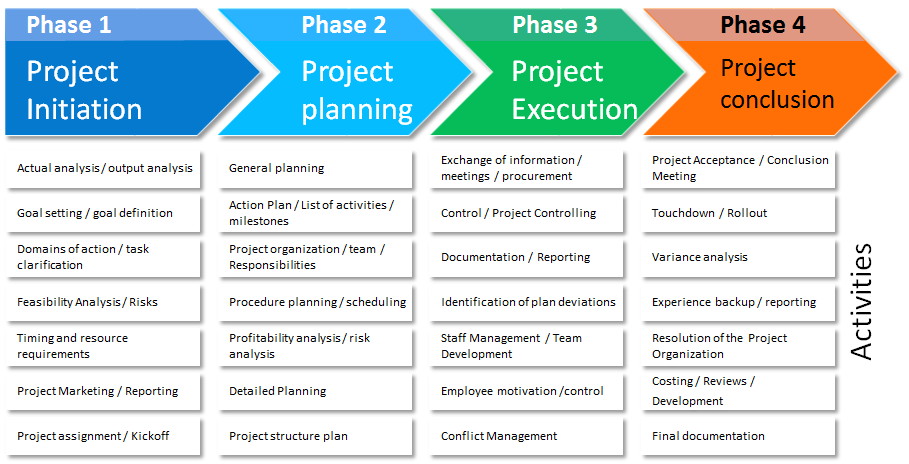
AFiT 4Ds Implementation Consulting Service | "Our Team of Dedicated Individuals Makes a Committment to Act as One"
As an integral part of AFiT® professional services, our team has extensive experience building innovative Web applications. AFiT® 4Ds Solutions Process captures this team’s collective knowledge and expertise in a set of best practices that includes Objectives, Time Windows, Roles, Deliverables, and Activities.
AFiT® process is customized based on Agile Unified Process (AUP) for building Web applications differs from conventional methodologies in its balanced approach to project management, technical implementation, and user-centered design. The focus of typical application development methodologies is keeping projects on schedule and on budget. In today’s environment of rapidly accelerating competition, methodologies must do more. AFiT® 4Ds Solutions Process goes beyond scheduling and budget management, to include activities and deliverables that build competitive advantage. The competitive advantage in Web applications is center on valuable user experiences. Therefore, a critical component of AFiT® 4Ds Solutions Process is synergy between technology and experiential design.
AGILE UP®
Agile Unified Process (AUP) is a simplified version of the IBM Rational Unified Process (RUP) developed by Scott Ambler.[1] It describes a simple, easy to understand approach to developing business application software using agile techniques and concepts yet still remaining true to the RUP. The AUP applies agile techniques including test driven development (TDD), Agile Modeling, agile change management, and database refactoring to improve productivity.
Unlike the RUP, the AUP has only seven disciplines:
- Model. Understand the business of the organization, the problem domain being addressed by the project, and identify a viable solution to address the problem domain.
- Implementation. Transform model(s) into executable code and perform a basic level of testing, in particular unit testing.
- Test. Perform an objective evaluation to ensure quality. This includes finding defects, validating that the system works as designed, and verifying that the requirements are met.
- Deployment. Plan for the delivery of the system and to execute the plan to make the system available to end users.
- Configuration Management. Manage access to project artifacts. This includes not only tracking artifact versions over time but also controlling and managing changes to them.
- Project Management. Direct the activities that take place within the project. This includes managing risks, directing people (assigning tasks, tracking progress, etc.), and coordinating with people and systems outside the scope of the project to be sure that it is delivered on time and within budget.
- Environment. Support the rest of the effort by ensuring that the proper process, guidance (standards and guidelines), and tools (hardware, software, etc.) are available for the team as needed.
THE METHODOLOGY
AFiT® 4Ds Solutions Process consists of four comprehensive phases -- Define, Application Design, Implementation Development, and Deployment. Each phase involves a number of different roles, a variety of planning and/or development activities, and one or more presentations by AFiT® to you, culminating in key deliverables that make it possible to move on to the next phase of the process. Though well defined, the Web Solutions Process is not restrictive–it maintains the flexibility needed to meet your unique requirements and accommodate continual market and industry changes.
AFiT® has sufficient information regarding the in-house skills, implementation process and experience available to the project owners. As such providing a definitive response to your service needs is not possible at this stage though we look forward to working with you to identify the precise requirements.

Based on AFiT® 4Ds Methodology, it is typically divided into four phases. These phases provide a framework for the entire process of creating a web-based application. The grouping as well as the duration and scope of the phases may change depending on particular project requirements, but the general flow will remain constant.
The DEFINE (planning and scoping) phase provides the opportunity to understand the client's goals and requirements or for your Systems Integrator to help you develop these. The planning phase is most often grouped with the application design phase. It may be broken out on its own if you do not have a well defined plan to enter directly into the application design phase. In addition, this is when the project manager, design lead and tech lead plan the overall project.
The DESIGN (application design) phase is for research and exploration leading to a prototype, a feature specification, and a technical architecture, collectively referred to as the blueprint.
The DEVELOPMENT (development and integration) phase includes detailed design and engineering. It results in a completed, documented, tested application.
The DEPLOYMENT (deployment and support) includes training, installation, rollout and ongoing support.
